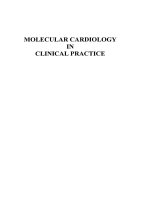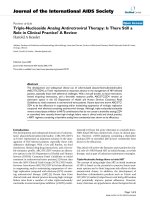Fracture Classifications in Clinical Practice pptx
Bạn đang xem bản rút gọn của tài liệu. Xem và tải ngay bản đầy đủ của tài liệu tại đây (2.67 MB, 114 trang )
Fracture
Classifications in
Clinical Practice
Seyed Behrooz Mostofi
With 70 Figures
Seyed Behrooz Mostofi, FRCS (Tr & Orth)
Senior Registrar in Orthopaedics
South East Thames Rotation
University of London
United Kingdom
British Library Cataloguing in Publicaion Data
Mostofi, Seyed Behrooz
Fracture classifications in clinical practice
1. Fractures – Classification
I. Title
617.1¢5¢012
ISBN-10: 1846280257
Library of Congress Control Number: 2005925986
ISBN-10: 1-84628-025-7 e-ISBN: 1-84628-144-X Printed on acid-free paper
ISBN-13: 978-1-84628-025-2
© Springer-Verlag London Limited 2006
Whilst we have made considerable efforts to contact all holders of copyright mate-
rial contained in this book, we may have failed to locate some of them. Should
holders wish to contact the Publisher, we will be happy to come to some arrange-
ment with them.
Apart from any fair dealing for the purposes of research or private study, or criti-
cism or review, as permitted under the Copyright, Designs and Patents Act 1988,
this publication may only be reproduced, stored or transmitted, in any form or by
any means, with the prior permission in writing of the publishers, or in the case of
reprographic reproduction in accordance with the terms of licences issued by the
Copyright Licensing Agency. Enquiries concerning reproduction outside those
terms should be sent to the publishers.
The use of registered names, trademarks, etc. in this publication does not imply,
even in the absence of a specific statement, that such names are exempt from the
relevant laws and regulations and therefore free for general use.
Product liability: The publisher can give no guarantee for information about drug
dosage and application thereof contained in this book. In every individual case
the respective user must check its accuracy by consulting other pharmaceutical
literature.
Printed in the United States of America. (BS/MVY)
987654321
Springer Science+Business Media
springeronline.com
Foreword
This is one of those necessary books to which one rushes to
confirm that one’s memory of fracture classification is correct. It
is succinctly written and well referenced, providing a quick and
easy aide memoir of fracture patterns. Drawn from many
sources, a number of classifications are usefully provided for
each fracture area.
Whether as a useful introduction to trauma, or as an essen-
tial prior to examination, with this book Behrooz Mostofi has
produced a little gem.
Barry Hinves
Chair, Specialist Training Committee
South East Thames Rotation
University of London
United Kingdom
Preface
The staff in accident and emergency departments and doctors in
fracture clinics alike may at times find themselves inadequately
equipped to identify the exact type of a given fracture without
access to a textbook.
Classification is an essential aid, which guides clinical judge-
ment. It has been developed to facilitate organisation of seem-
ingly distinct but related fractures into different clinically useful
groups. Ideally, it provides a reliable language of communication
guidelines for treatment, and allows reasonable progress to be
drawn for a specific type of fracture. However, the “ideal” classi-
fication system that would fulfill these requirements does not
exist. As a result, numerous classification systems are published
for each fracture; some are more used in one geographical loca-
tion than others.
This book makes no attempt to produce a comprehensive list
of all classifications. Rather, it includes those practical systems
which have proven helpful in everyday clinical practice to a
majority of surgeons. This book aims to provide enough essen-
tial information to complete the major task of identification and
analysis of fracture, which is the first step in treatment.
As other systems of classification evolve over time, the likeli-
hood that the classifications in this book will continue to provide
guidance for fracture care remains high. I accept responsibility
for any shortcomings in this book and corrections will be gladly
made in the next edition.
Seyed Behrooz Mostofi
London
August 2005
Acknowledgments
I am grateful to Dr. Andrée Bates whose unfailing support is a
source of inspiration.
I acknowledge the help and advice of my old friend, and tal-
ented Orthopaedic Surgeon, Mr. H. Khairandish (Payman) from
whom I have benefited enormously.
I am indebted to Mr. Ravi Singh, Senior Registrar in
Orthopaedics for his encouragement and suggestions at the times
most needed.
I am grateful to the copyright holders for their kind permis-
sion to reproduce some of the original drawings.
I would like to give special thanks to Grant Weston, Hannah
Wilson, Barbara Chernow, and other staff at Springer for their
support and enthusiasm for the production of this book.
Most of the uninterrupted work was done at night well into
the early hours of the morning after clinics and surgery and over
the weekends. Therefore, I am also appreciative of my parents,
my family, especially my brother Dr. Seyed Behzad Mostofi, and
friends who understood the value of this to me and forgave me
for being constantly absent from social gatherings. They adjusted
themselves to my difficult hours of solitary work. I am grateful
to them all.
Contents
1 Spine . . . . . . . . . . . . . . . . . . . . . . . . . . . . . . . . . . . . 1
2 Shoulder and Upper Limb . . . . . . . . . . . . . . . . . . . . 11
3 Pelvis and Lower Limb . . . . . . . . . . . . . . . . . . . . . . . 37
4 Fractures in Children . . . . . . . . . . . . . . . . . . . . . . . . 79
5 Periprosthetic Fractures . . . . . . . . . . . . . . . . . . . . . . 90
Index . . . . . . . . . . . . . . . . . . . . . . . . . . . . . . . . . . . . . . . 97
Chapter 1
Spine
CERVICAL SPINE
Injuries to the Occiput-C1–C2 Complex
Anderson and Montisano Classification of Occipital
Condyle Fractures
Type I: impaction of condyle
Type II: associated with basilar or skull fractures
Type III: condylar avulsion
Atlanto-Occipital Dislocation (Craniovertebral Dissociation)
Classification Based on Position of the Occiput in
Relation to C1
Type I: Occipital condyles anterior to the atlas; most common
Type II: Condyles longitudinally result of pure distraction
Type III: Occipital condyles posterior to the atlas
Atlas Fractures
Levine and Edwards Classification
1. Burst Fracture (Jefferson Fracture). Axial load injury result-
ing in four fractures: two in the posterior arch and two in the
anterior arch.
2. Posterior arch fractures. Hyperextension injury that is associ-
ated with odontoid and axis fractures.
3. Comminuted fractures. Axial load and lateral bending
injury associated with high nonunion rate and poor clinical
result.
4. Anterior arch fractures. Hyperextension injury.
5. Lateral mass fractures. Axial Load and lateral bending injury.
6. Transverse process fracture. Avulsion injury.
7. Inferior tubercle fracture. Avulsion of the longus colli muscle.
Atlantoaxial Rotatory Subluxation and Dislocation
Fielding Classification (Figure 1.1)
Type I: Simple rotatory displacement without anterior shift.
Odontoid acts as a pivot point; transverse ligament
intact.
Type II: Rotatory displacement with anterior displacement of
3.5 mm. Opposite facet acts as a pivot; transverse liga-
ment insufficient.
Type III: Rotatory displacement with anterior displacement of
more than 5mm. Both joints anteriorly subluxed. Trans-
verse and alar ligaments incompetent.
Type IV: Rare; both joints posteriorly subluxed.
Type V: (Levine and Edwards) frank dislocation; extremely rare.
Fractures of the Odontoid Process (Dens)
Anderson and D’Alonzo Classification (Figure 1.2)
Type I: Oblique avulsion fracture of the apex (5%).
Type II: Fracture at the junction of the body and the neck; high
nonunion rate (60%).
Type III: Fracture extends into the body of C2 and may involve
the lateral facets (30%).
2 FRACTURE CLASSIFICATIONS IN CLINICAL PRACTICE
FIGURE
1.1. Fielding classification of atlantoaxial rotatory subluxation
and dislocation. (Reproduced with permission and copyright © of the
Journal of Bone and Joint Surgery, Inc. Fielding WJ, Hawkins RJ;
Atlanto-axial rotatory fixation (Fixed rotatory subluxation of the atlanto-
axial joint). J Bone Joint Surg 1977;59-A:37–44.)
TRAUMATIC SPONDYLOLISTHESIS OF AXIS
(HANGMAN’S FRACTURE)
Levine and Edwards (Figure 1.3)
Type I: Minimally displaced with no angulation; translation
<3 mm; stable.
Type II: Significant angulation at C2–C3; translation >3mm;
unstable; C2–C3 disc disrupted. Subclassified into
flexion, extension, and listhetic types.
Type IIA: Avulsion of entire C2–C3 intervertebral disc in flexion,
leaving the anterior longitudinal ligament intact.
Results in severe angulation. No translation; unstable
due to flexion-distraction injury.
Type III: Rare; results from initial anterior facet dislocation of
C2 on C3 followed by extension injury fracturing the
neural arch. Results in severe angulation and transla-
tion with unilateral or bilateral facet dislocation of
C2–C3; unstable.
1. SPINE 3
FIGURE 1.2. Anderson and D’Alonzo classification of fractures of the
odontoid process (Dens). (Reproduced with permission and copyright ©
of The Journal of Bone and Joint Surgery, Inc. Anderson LD, d’Alonzo
RT. Fractures of the Odontoid process of the axis. J Bone Joint Surg Am
1974;56A:1663–1674.)
INJURIES TO C3–C7
Allen Classification
1. Compressive flexion (shear mechanism resulting in “teardrop”
fractures)
Stage I: Blunting of anterior body; posterior element intact.
Stage II: “Beaking” of the anterior body; loss of anterior ver-
tebral height.
4 FRACTURE CLASSIFICATIONS IN CLINICAL PRACTICE
F
IGURE 1.3. Levine and Edwards classification of Traumatic Spondy-
lolisthesis of axis: Type I (top left), Type II (top right), Type IIA (bottom
left), Type III (bottom right). (Reproduced with permission and copyright
© of The Journal of Bone and Joint Surgery, Inc. Levine AM, Edwards
CC. The management of traumatic spondylolisthesis of the axis. J Bone
Joint Surg Am 1985;67A:217–226.)
Stage III: Fracture line passing from anterior body through
the inferior subchondral plate.
Stage IV: Inferoposterior margin displaced <3mm into the
spinal canal.
Stage V: Teardrop fracture; inferoposterior margin >3mm
into the spinal canal; posterior ligaments and the
posterior longitudinal ligament have failed.
2. Vertical compression (burst fractures)
Stage I: Fracture through superior or inferior endplate with
no displacement.
Stage II: Fracture through both endplates with minimal
displacement.
Stage III: Burst fracture; displacement of fragments periph-
erally and into the neural canal.
3. Distractive flexion (dislocations)
Stage I: Failure of the posterior ligaments, divergence of
spinous processes, and facet subluxation.
Stage II: Unilateral facet dislocation; displacement is always
<50%.
Stage III: Bilateral facet dislocation; displacement >50%.
Stage IV: Bilateral facet dislocation with 100% translation.
4. Compressive extension
Stage I: Unilateral vertebral arch fracture.
Stage II: Bilaminar fracture without other tissue failure.
Stage III: Bilateral vertebral arch fracture with fracture of the
articular processes, pedicles, and lamina without
vertebral body displacement.
Stage IV: Bilateral vertebral arch fracture with full ver-
tebral body displacement anteriorly; ligamentous
failure at the posterosuperior and anteroinferior
margins.
5. Distractive extension
Stage I: Failure of anterior ligamentous complex or trans-
verse fracture of the body; widening of the disc
space and no posterior displacement.
Stage II: Failure of posterior ligament complex with
displacement of the vertebral body into the
canal.
6. Lateral flexion
Stage I: Asymmetric unilateral compression fracture of the
vertebral body plus a vertebral arch fracture on the
ipsilateral side without displacement.
Stage II: Displacement of the arch on the anteroposterior
view or failure of the ligaments on the contralateral
side with articular process separation.
1. SPINE 5
ORTHOPAEDIC TRAUMA ASSOCIATION (OTA)
CLASSIFICATION OF CERVICAL SPINE INJURIES
Type A: Compression injuries of the body (compressive forces)
Type A1: Impaction fractures
Type A2: Split fractures
Type A3: Burst fractures
Type B: Distraction injuries of the anterior and posterior ele-
ments (tensile forces)
Type B2: Posterior disruption predominantly osseous
(flexion-distraction injury)
Type B3: Anterior disruption through the disk (hyper-
extension-shear injury)
Type C: Multidirectional injuries with translation affecting the
anterior and posterior elements (axial torque causing
rotation injuries)
Type C1: Rotational wedge, split, and burst fractures
Type C2: Flexion subluxation with rotation
Type C3: Rotational shear injuries (Holdsworth slice
rotation fracture)
THORACOLUMBAR SPINE FRACTURES
McAfee Classification
Classification is based on the failure mode of the middle oste-
oligamentous complex (posterior longitudinal ligament, poste-
rior half of the vertebral body, and posterior annulus fibrosus):
The six injury patterns are the following:
1. Wedge-compression fracture
2. Stable burst fracture
3. Unstable burst fracture
4. Chance fracture
5. Flexion-distraction injury
6. Translational injuries
Denis Classification
The three-column model according to Denis (Figure 1.4):
Anterior Column:
Anterior longitudinal ligament
Anterior half of vertebral body
Anterior portion of annulus fibrosis
6 FRACTURE CLASSIFICATIONS IN CLINICAL PRACTICE
Middle column:
Posterior longitudinal ligament
Posterior half of vertebral body
Posterior aspect of annulus fibrosis
Posterior column:
Neural arch
Ligamentum flavum
Facet capsule
Interspinous ligament
1. SPINE 7
FIGURE 1.4. Denis’ concept of three-column model.
Based on the three-column model, fractures are classified accord-
ing to the mechanism of injury and the resulting fracture pattern
into one of the following categories (see Table 1.1):
1. Compression
2. Burst
3. Flexion-Distraction
4. Fracture-Dislocation
1. Compression Fractures
Four subtypes described on the basis of endplate involvement are
as follows:
Type A: Fracture of both endplates
Type B: Fractures of the superior endplate
Type C: Fractures of the inferior endplate
Type D: Both endplates intact
2. Burst Fractures (Figure 1.5)
Type A: Fractures of both endplates
Type B: Fracture of the superior endplate
Type C: Fracture of the inferior endplate
Type D: Burst rotation
Type E: Burst lateral flexion
3. Flexion-Distraction Injuries (Chance Fractures, Seat Belt-Type
Injuries)
Type A: One-level bony injury
Type B: One-level ligamentous
Type C: Two-level injury through bony middle column
Type D: Two-level injury through ligamentous middle column
8 FRACTURE CLASSIFICATIONS IN CLINICAL PRACTICE
TABLE 1.1. Pattern of failure.
Column
Type Anterior Middle Posterior
1. Compression Compression none none/distraction
2. Burst Compression Compression None/Splaying
of pedicles
3. Flexion- None/Distraction Distraction distraction
Distraction
4. Flexion- Compression/ Compression/ Compression
Dislocation Rotation/shear Rotation/shear Rotation/shear
4. Fracture Dislocations
Type A: Flexion-rotation. Posterior and middle column fail in ten-
sion and rotation; anterior column fails in compression and
rotation;75% have neurological deficits, 52% of these are
complete lesions.
Type B: Shear. Shear failure of all three columns, most commonly
in the postero-anterior direction; all cases with complete neu-
rological deficits.
Type C: Flexion-distraction. Tension failure of posterior and mid-
dle columns, with anterior tear of annulus fibrosus and strip-
ping of the anterior longitudinal ligament; 75% with
neurological deficits (all incomplete).
1. SPINE 9
FIGURE 1.5. Burst thoracolumbar spine fractures.
SACRAL FRACTURES (Figure 1.6)
Denis Classification
Zone 1: the region of the ala
Zone 2: the region of the sacral foramina
Zone 3: the region of central sacral canal
10 FRACTURE CLASSIFICATIONS IN CLINICAL PRACTICE
FIGURE 1.6. Denis classification of sacral fractures.
Chapter 2
Shoulder and Upper Limb
CLAVICLE
Craig Classification
Group I: Fracture of the middle third
Group II: Fracture of the distal third. Subclassified according
to the location of coracoclavicular ligaments relative
to the fracture as follows:
Type I: Minimal displacement: interligamentous
fracture between conoid and trapezoid or
between the coracoclavicular and acromio-
cavicular ligaments
Type II: Displaced secondary to a fracture medial to
the coracoclavicular ligaments – higher
incidence of non-union
IIA: Conoid and trapezoid attached to the
distal segment (see Figure 2.1)
IIB: Conoid torn, trapezoid attached to the
distal segment (see Figure 2.2)
Type III: Fracture of the articular surface of the
acromioclavicular joint with no ligamen-
tous injury – may be confused with first-
degree acromioclavicular joint separation
Group III: Fracture of the proximal third:
Type I: Minimal displacement
Type II: Significant displaced (ligamentous rupture)
Type III: Intraarticular
Type IV: Epiphyseal separation
Type V: Comminuted
Acromioclavicular Joint
Rockwood Classification (Figure 2.3)
Type I
Sprain of the acromioclavicular (AC) ligament.
AC joint tenderness, minimal pain with arm motion, no pain
in coracoclavicular interspaces.
No abnormality on radiographs.
Type II
AC ligament tear with joint disruption and sprained cora-
coclavicular ligaments. Distal clavicle is slightly superior to
acromion and mobile to palpation; tenderness is found in
the coracoclavicular space.
12 FRACTURE CLASSIFICATIONS IN CLINICAL PRACTICE
FIGURE 2.1. Type IIA clavicular fracture according to Craig classification.
(Reprinted from Craig EV. Fractures of the clavicle in Rockwood CA,
Matsen FA (eds): The shoulder. Philadelphia, Saunders © 1990, with per-
mission from Elsevier.)
FIGURE 2.2. Type IIB clavicular fracture according to Craig classification.
(Reprinted from Craig EV. Fractures of the clavicle in Rockwood CA,
Matsen FA (eds): The shoulder. Philadelphia, Saunders © 1990, with per-
mission from Elsevier.)
Radiographs demonstrate slight elevation of the distal end
of the clavicle and AC joint widening. Stress films show the
coracoclavicular ligaments are sprained but integrity is
maintained.
Type III
AC and coracoclavicular ligaments torn with AC joint dis-
location; deltoid and trapezius muscles usually detached
from the distal clavicle.
The upper extremity and distal fragment are depressed, and
the distal end of the proximal fragment may tent the skin.
The AC joint is tender, coracoclavicular widening is evident.
2. SHOULDER AND UPPER LIMB 13
FIGURE 2.3. Types I–VI of the Rockwood classification for acromioclav-
icular joints. (Reproduced from Heckman JD, Bucholz RW (Eds).
Rockwood, Green and Wilkins’ Fractures in Adults, Philadelphia: 2001.)
Radiographs demonstrate the distal clavicle superior to
the medial border of the acromion; stress views reveal a
widened coracoclavicular interspace 25% to 100% greater
than the normal side.
Type IV
Type III with the distal clavicle displaced posteriorly into or
through the trapezius.
Clinically, more pain exists than in type III; the distal clav-
icle is displaced posteriorly away from the clavicle.
Axillary radiograph or computed tomography demonstrates
posterior displacement of the distal clavicle.
Type V
Type III with the distal clavicle grossly and severely dis-
placed superiorly.
This type is typically associated with tenting of the skin.
Radiographs demonstrate the coracoclavicular interspace
to be 100% to 300% greater than the normal side.
Type VI
AC dislocated, with the clavicle displaced inferior to the
acromion or the coracoid; the coracoclavicular interspace is
decreased compared with normal.
The deltoid and trapezius muscles are detached from the
distal clavicle.
The mechanism of injury is usually a severe direct force
onto the superior surface of the distal clavicle, with abduc-
tion of the arm and scapula retraction.
Clinically, the shoulder has a flat appearance with a pro-
minent acromion; associated clavicle and upper rib frac-
tures and brachial plexus injuries are due to high energy
trauma.
Radiographs demonstrate one of two types of inferior dis-
location: subacromial or subcoracoid.
Sternoclavicular Joint
Anatomic Classification
Anterior dislocation – more common
Posterior dislocation
Etiologic Classification
Sprain or subluxation
Mild: joint stable, ligamentous integrity maintained.
Moderate: subluxation, with partial ligamentous disruption.
Severe: unstable joint, with complete ligamentous compromise.
14 FRACTURE CLASSIFICATIONS IN CLINICAL PRACTICE
SCAPULA
Zdravkovic and Damholt Classification
Type I: Scapula body
Type II: Apophyseal fractures, including the acromion and
coracoid
Type III: Fractures of the superolateral angle, including the
scapular neck and glenoid
Coracoid Fractures
Eyres and Brooks Classification (Figure 2.4)
Type I: Coracoid tip or epiphyseal fracture
Type II: Mid process
2. SHOULDER AND UPPER LIMB 15
FIGURE 2.4. Types I–V of the Eyres and Brooks classification for coracoid
fractures. (Reproduced with permission and copyright © of the British
Editorial Society of Bone and Joint Surgery. Eyre KS, Brook A, Stanley
D. Fractures of coracoid process. J Bone Joint Surg 1995;77B:425–428.)









